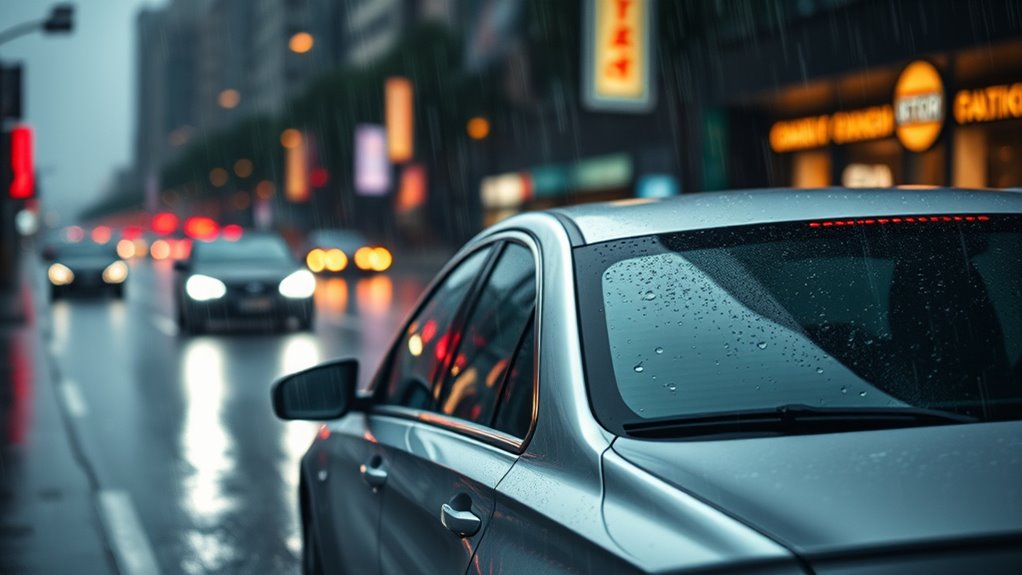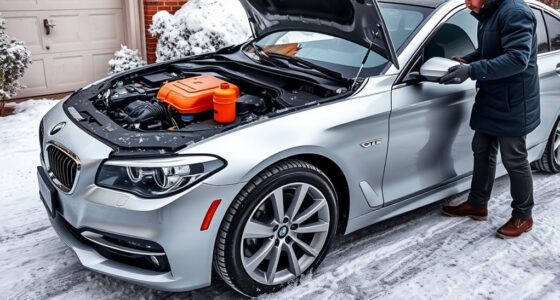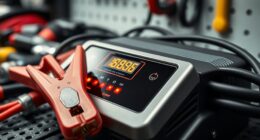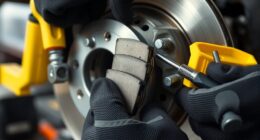Before driving in wet weather, make certain your tires have good tread and proper pressure to prevent hydroplaning. Check that your windshield wipers work well and consider using rain-repellent fluids to clear your view better. Reduce your speed, increase following distance, and turn on your headlights to stay visible. Staying prepared with these tips can make a big difference—continue exploring more ways to stay safe during rainy days.
Key Takeaways
- Regularly check and replace worn tires and ensure proper inflation for optimal traction on wet roads.
- Maintain and replace windshield wipers to ensure clear visibility during rain.
- Use rain-repellent windshield washer fluids to improve cleaning and reduce streaks.
- Drive at reduced speeds and increase following distances to enhance safety in wet conditions.
- Keep emergency supplies and a spare wiper blade in your vehicle for quick rain-related repairs.

Rainy days can be tough on your car, but with a little preparation, you can keep your vehicle in top shape despite the weather. One of the most critical aspects of safe driving in wet conditions is ensuring your tires are ready to grip the road. Check your tire tread regularly; it’s what channels water away from the contact patch and helps prevent hydroplaning. If you notice your tire tread is worn down to the wear bars or appears shallow, it’s time to replace your tires. Proper tread depth is essential because it maintains traction and reduces the risk of slipping on slick surfaces. Don’t forget to keep your tires properly inflated, as under-inflated tires can worsen traction problems, especially during heavy rain. Regularly inspecting your tires and maintaining the correct pressure can make a significant difference in wet weather safety. Additionally, if you are considering upgrading your bike for off-road adventures, exploring electric dirt bikes with higher horsepower and improved traction can give you more confidence on wet trails.
Alongside tire condition, your windshield wipers play a vital role during rainy days. Wipers clear rain, snow, and debris from your windshield, giving you a clear view of the road ahead. Before you hit the road, ensure your windshield wipers are in good shape. If the blades are cracked, torn, or leave streaks after a swipe, it’s time to replace them. Worn wipers can impair visibility just when you need it most, increasing your risk of accidents. Keep a spare set in your car, especially during the rainy season, so you can swap them out quickly if needed. Also, top off your windshield washer fluid with a rain-repellent formula if possible; this helps your wipers do their job more effectively and keeps your windshield cleaner.
Driving in wet weather demands more vigilance. Reduce your speed to give yourself more time to react to hydroplaning or sudden stops. Maintain a safe following distance—at least four seconds behind the vehicle ahead—so you don’t have to brake abruptly if the road gets slick. Use your headlights, not just for seeing but also for being seen by others. Remember, your vehicle’s ability to maintain traction and your visibility are directly linked to proper tire tread and functioning windshield wipers. Taking care of these basic maintenance tasks ensures you’ll have better control and more visibility, which are crucial for safe driving in rain. With these simple precautions, you can confidently navigate wet roads and arrive safely at your destination, rain or shine.
Frequently Asked Questions
How Often Should I Replace My Windshield Wipers During Rainy Seasons?
You should replace your windshield wipers every 6 to 12 months to guarantee maximum visibility. Wiper blade longevity can vary based on weather and use, so during the rainy season, it’s important to stay vigilant. Regular rain-related maintenance, like inspecting for cracks or streaks, helps prevent reduced performance. If your wipers leave streaks or chatter, it’s time for a replacement to stay safe and maintain clear sightlines in wet conditions.
What’S the Best Way to Dry My Brakes After Driving Through Heavy Rain?
Ever thought about your brakes drying themselves? Well, they don’t—so you need to help them. Use gentle brake drying techniques, like lightly applying pressure on the pedal after driving through heavy rain, to remove excess water. Remember, brake maintenance tips include checking for moisture and ensuring your brake pads and fluid are in good shape. This way, you keep your stopping power sharp and safe, rain or shine.
How Can I Prevent Hydroplaning on Wet Roads?
To prevent hydroplaning, you should regularly check your tire tread to make certain it’s deep enough to channel water away. Keep your tires properly inflated, as under-inflated tires increase the risk of hydroplaning. Slow down when roads are wet, especially during heavy rain, and avoid sudden maneuvers. Maintaining these precautions helps your tires grip the wet surface better, reducing the likelihood of losing traction and hydroplaning.
Are All Tires Equally Effective in Wet Weather Conditions?
Not all tires are equally effective in wet weather. You should check your tire tread regularly because deeper treads provide better grip and channel water away. Also, keep your tire pressure at the recommended level; underinflated tires reduce contact with the road, increasing the risk of hydroplaning. Properly maintained tires with adequate tread and correct pressure help make certain safer driving in wet conditions.
When Should I Replace My Windshield Washer Fluid in Rainy Weather?
Think of your windshield washer fluid as your shield against rain’s assault. You should replace it when your fluid quality testing shows it’s diluted or contaminated, especially in rainy weather. Regular washer fluid maintenance guarantees clear visibility, so check and top off your reservoir frequently. Don’t wait until your windshield is foggy; proactive fluid replacement keeps your view sharp and driving safe during heavy downpours.
Conclusion
Remember, driving in wet weather is like steering a river—you’re in control, but need to stay alert. Keep your tires, brakes, and windshield in top shape, and slow down when the roads are slick. By staying cautious and prepared, you’ll glide smoothly through rainstorms instead of getting caught in a storm of trouble. Stay safe out there, and let the rain be just a gentle drizzle rather than a dangerous deluge.









